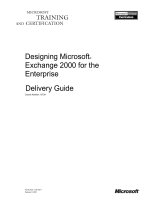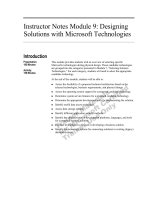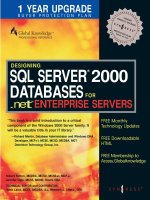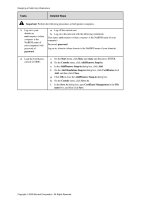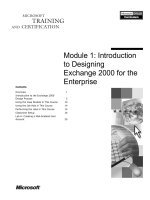Designing BSD rootkits
Bạn đang xem bản rút gọn của tài liệu. Xem và tải ngay bản đầy đủ của tài liệu tại đây (8.38 MB, 164 trang )
Though rootkits have a fairly negative image, they
can be used for both good and evil. Designing BSD
Rootkits arms you with the knowledge you need to write
offensive rootkits, to defend against malicious ones, and
to explore the FreeBSD kernel and operating system in
the process.
Organized as a tutorial, Designing BSD Rootkits will
teach you the fundamentals of programming and
developing rootkits under the FreeBSD operating system.
Author Joseph Kong’s goal is to make you smarter, not
to teach you how to write exploits or launch attacks.
You’ll learn how to maintain root access long after gain-
ing access to a computer, and how to hack FreeBSD.
Kong’s liberal use of examples assumes no prior
kernel-hacking experience but doesn’t water down
the information. All code is thoroughly described and
analyzed, and each chapter contains at least one
real-world application.
www.nostarch.com
“ I L AY F L AT.”
This book uses RepKover — a durable binding that won’t snap shut.
TH E FI N E ST I N G E E K E NT E RTAI N M E N T
™
SHELVE IN:
COMPUTER SECURITY/
OPERATING SYSTEMS
$29.95 ($36.95 CDN)
®
W R I T E A N D
D E F E N D A G A I N S T
B S D R O O T K I T S
W R I T E A N D
D E F E N D A G A I N S T
B S D R O O T K I T S
Included:
• The fundamentals of FreeBSD kernel-module programming
• Using call hooking to subvert the FreeBSD kernel
• Directly manipulating the objects that the kernel
depends upon for its internal record-keeping
• Patching kernel code resident in main memory;
in other words, altering the kernel’s logic while it’s
still running
• How to defend against the attacks described
So go right ahead. Hack the FreeBSD kernel yourself!
A B O U T T H E A U T H O R
Tinkering with computers has always been a primary
passion of author Joseph Kong. He is a self-taught
programmer who dabbles in information security,
operating system theory, reverse engineering, and
vulnerability assessment. He has written for Phrack
Magazine and was a system administrator for the City
of Toronto.
D E S I G N I N G
B S D R O O T K I T S
D E S I G N I N G
B S D R O O T K I T S
A N I N T R O D U C T I O N T O K E R N E L H A C K I N G
J O S E P H K O N G
®
D E S I G N I N G B S D R O O T K I T S
K O N G
D E S I G N I N G B S D R O O T K I T S
®
DESIGNING BSD ROOTKITS
DESIGNING BSD
ROOTKITS
An Introduction to
Kernel Hacking
by Joseph Kong
San Francisco
®
DESIGNING BSD ROOTKITS. Copyright © 2007 by Joseph Kong.
All rights reserved. No part of this work may be reproduced or transmitted in any form or by any means, electronic or
mechanical, including photocopying, recording, or by any information storage or retrieval system, without the prior
written permission of the copyright owner and the publisher.
11 10 09 08 07 1 2 3 4 5 6 7 8 9
ISBN-10: 1-59327-142-5
ISBN-13: 978-1-59327-142-8
Publisher: William Pollock
Production Editor: Elizabeth Campbell
Cover and Interior Design: Octopod Studios
Developmental Editor: William Pollock
Technical Reviewer: John Baldwin
Copyeditor: Megan Dunchak
Compositors: Riley Hoffman and Megan Dunchak
Proofreader: Riley Hoffman
Indexer: Nancy Guenther
For information on book distributors or translations, please contact No Starch Press, Inc. directly:
No Starch Press, Inc.
555 De Haro Street, Suite 250, San Francisco, CA 94107
phone: 415.863.9900; fax: 415.863.9950; ; www.nostarch.com
Library of Congress Cataloging-in-Publication Data
Kong, Joseph.
Designing BSD rootkits : an introduction to kernel hacking / Joseph Kong.
p. cm.
Includes index.
ISBN-13: 978-1-59327-142-8
ISBN-10: 1-59327-142-5
1. FreeBSD. 2. Free computer software. 3. Operating systems (Computers) I. Title.
QA76.76.O63K649 2007
005.3 dc22
2007007644
No Starch Press and the No Starch Press logo are registered trademarks of No Starch Press, Inc. Other product and
company names mentioned herein may be the trademarks of their respective owners. Rather than use a trademark
symbol with every occurrence of a trademarked name, we are using the names only in an editorial fashion and to the
benefit of the trademark owner, with no intention of infringement of the trademark.
The information in this book is distributed on an “As Is” basis, without warranty. While every precaution has been
taken in the preparation of this work, neither the author nor No Starch Press, Inc. shall have any liability to any
person or entity with respect to any loss or damage caused or alleged to be caused directly or indirectly by the
information contained in it.
Printed on recycled paper in the United States of America
To those who follow their dreams and specialize in the impossible.
ACKNOWLEDGMENTS
Foremost, I am especially grateful to Bill Pollock for his belief in me and for
his help in this book, as well as giving me so much creative control. His num-
erous reviews and suggestions show in the final result (and yes, the rumors
are true, he does edit like a drill sergeant). I would also like to thank Elizabeth
Campbell for, essentially, shepherding this entire book (and for remaining
cheerful at all times, even when I rewrote an entire chapter, after it had been
through copyedit). Thanks to Megan Dunchak for performing the copyedit
and for improving the “style” of this book, and to Riley Hoffman for reviewing
the entire manuscript for errors. Also, thanks to Patricia Witkin, Leigh Poehler,
and Ellen Har for all of their work in marketing.
I would also like to thank John Baldwin, who served as this book’s tech-
nical reviewer, but went beyond the normal call of duty to provide a wealth
of suggestions and insights; most of which became new sections in this book.
Also, I would like to thank my brother for proofreading the early drafts
of this book, my dad for getting me into computers (he’s still the best hacker
I know), and my mom for, pretty much, everything (especially her patience,
because I was definitely a brat growing up).
Last but not least, I would like to thank the open-source software/hacker
community for their innovation, creativity, and willingness to share.
BRIEF CONTENTS
Foreword by John Baldwin xiii
Introduction xv
Chapter 1: Loadable Kernel Modules 1
Chapter 2: Hooking 23
Chapter 3: Direct Kernel Object Manipulation 37
Chapter 4: Kernel Object Hooking 59
Chapter 5: Run-Time Kernel Memory Patching 63
Chapter 6: Putting It All Together 91
Chapter 7: Detection 119
Closing Words 127
Bibliography 129
Index 131
CONTENTS IN DETAIL
FOREWORD by John Baldwin xiii
INTRODUCTION xv
What Is a Rootkit? xvi
Why FreeBSD? xvi
The Goals of This Book xvi
Who Should Read This Book? xvi
Contents Overview xvi
Conventions Used in This Book xvii
Concluding Remarks xvii
1
LOADABLE KERNEL MODULES 1
1.1 Module Event Handler 2
1.2 The DECLARE_MODULE Macro 3
1.3 “Hello, world!” 4
1.4 System Call Modules 6
1.4.1 The System Call Function 6
1.4.2 The sysent Structure 7
1.4.3 The Offset Value 8
1.4.4 The SYSCALL_MODULE Macro 8
1.4.5 Example 9
1.4.6 The modfind Function 10
1.4.7 The modstat Function 10
1.4.8 The syscall Function 11
1.4.9 Executing the System Call 11
1.4.10 Executing the System Call Without C Code 12
1.5 Kernel/User Space Transitions 12
1.5.1 The copyin and copyinstr Functions 13
1.5.2 The copyout Function 13
1.5.3 The copystr Function 13
1.6 Character Device Modules 14
1.6.1 The cdevsw Structure 14
1.6.2 Character Device Functions 15
1.6.3 The Device Registration Routine 16
1.6.4 Example 17
1.6.5 Testing the Character Device 19
1.7 Linker Files and Modules 21
1.8 Concluding Remarks 22
x Contents in Detail
2
HOOKING 23
2.1 Hooking a System Call 24
2.2 Keystroke Logging 26
2.3 Kernel Process Tracing 28
2.4 Common System Call Hooks 29
2.5 Communication Protocols 30
2.5.1 The protosw Structure 30
2.5.2 The inetsw[] Switch Table 31
2.5.3 The mbuf Structure 32
2.6 Hooking a Communication Protocol 32
2.7 Concluding Remarks 35
3
DIRECT KERNEL OBJECT MANIPULATION 37
3.1 Kernel Queue Data Structures 37
3.1.1 The LIST_HEAD Macro 38
3.1.2 The LIST_HEAD_INITIALIZER Macro 38
3.1.3 The LIST_ENTRY Macro 38
3.1.4 The LIST_FOREACH Macro 39
3.1.5 The LIST_REMOVE Macro 39
3.2 Synchronization Issues 39
3.2.1 The mtx_lock Function 40
3.2.2 The mtx_unlock Function 40
3.2.3 The sx_slock and sx_xlock Functions 40
3.2.4 The sx_sunlock and sx_xunlock Functions 41
3.3 Hiding a Running Process 41
3.3.1 The proc Structure 41
3.3.2 The allproc List 42
3.3.3 Example 43
3.4 Hiding a Running Process Redux 46
3.4.1 The hashinit Function 47
3.4.2 pidhashtbl 47
3.4.3 The pfind Function 48
3.4.4 Example 48
3.5 Hiding with DKOM 51
3.6 Hiding an Open TCP-based Port 52
3.6.1 The inpcb Structure 52
3.6.2 The tcbinfo.listhead List 53
3.6.3 Example 54
3.7 Corrupting Kernel Data 56
3.8 Concluding Remarks 57
4
KERNEL OBJECT HOOKING 59
4.1 Hooking a Character Device 59
4.1.1 The cdevp_list and cdev_priv Structures 60
4.1.2 The devmtx Mutex 60
4.1.3 Example 60
4.2 Concluding Remarks 62
Contents in Detail xi
5
RUN-TIME KERNEL MEMORY PATCHING 63
5.1 Kernel Data Access Library 63
5.1.1 The kvm_openfiles Function 64
5.1.2 The kvm_nlist Function 64
5.1.3 The kvm_geterr Function 65
5.1.4 The kvm_read Function 65
5.1.5 The kvm_write Function 65
5.1.6 The kvm_close Function 66
5.2 Patching Code Bytes 66
5.3 Understanding
x86 Call Statements 70
5.3.1 Patching Call Statements 70
5.4 Allocating Kernel Memory 73
5.4.1 The malloc Function 73
5.4.2 The MALLOC Macro 74
5.4.3 The free Function 74
5.4.4 The FREE Macro 74
5.4.5 Example 75
5.5 Allocating Kernel Memory from User Space 77
5.5.1 Example 77
5.6 Inline Function Hooking 81
5.6.1 Example 82
5.6.2 Gotchas 88
5.7 Cloaking System Call Hooks 88
5.8 Concluding Remarks 90
6
PUTTING IT ALL TOGETHER 91
6.1 What HIDSes Do 91
6.2 Bypassing HIDSes 92
6.3 Execution Redirection 92
6.4 File Hiding 96
6.5 Hiding a KLD 101
6.5.1 The linker_files List 102
6.5.2 The linker_file Structure 102
6.5.3 The modules List 103
6.5.4 The module Structure 103
6.5.5 Example 104
6.6 Preventing Access, Modification, and Change Time Updates 107
6.6.1 Change Time 108
6.6.2 Example 112
6.7 Proof of Concept: Faking Out Tripwire 114
6.8 Concluding Remarks 117
7
DETECTION 119
7.1 Detecting Call Hooks 120
7.1.1 Finding System Call Hooks 120
xii Contents in Detail
7.2 Detecting DKOM 123
7.2.1 Finding Hidden Processes 123
7.2.2 Finding Hidden Ports 125
7.3 Detecting Run-Time Kernel Memory Patching 125
7.3.1 Finding Inline Function Hooks 125
7.3.2 Finding Code Byte Patches 125
7.4 Concluding Remarks 126
CLOSING WORDS 127
BIBLIOGRAPHY 129
INDEX 131
FOREWORD
I have been working on various parts of the FreeBSD
kernel for the past six years. During that time, my focus
has always been on making FreeBSD more robust. This
often means maintaining the existing stability of the
system while adding new features or improving stability by fixing bugs and/or
design flaws in the existing code. Prior to working on FreeBSD, I served as a
system administrator for a few networks; my focus was on providing the desired
services to users while protecting the network from any malicious actions.
Thus, I have always been on the defensive “side” of the game when it comes
to security.
Joseph Kong provides an intriguing look at the offensive side in Designing
BSD Rootkits. He enumerates several of the tools used for constructing rootkits,
explaining the concepts behind each tool and including working examples
for many of the tools, as well. In addition, he examines some of the ways to
detect rootkits.
Subverting a running system requires many of the same skills and tech-
niques as building one. For example, both tasks require a focus on stability. A
rootkit that reduces the stability of the system risks attracting the attention of
a system administrator if the system crashes. Similarly, a system builder must
xiv Foreword
build a system that minimizes downtime and data loss that can result from
system crashes. Rootkits must also confront some rather tricky problems, and
the resulting solutions can be instructive (and sometimes entertaining) to
system builders.
Finally, Designing BSD Rootkits can also be an eye-opening experience for
system builders. One can always learn a lot from another’s perspective. I can-
not count the times I have seen a bug solved by a fresh pair of eyes because
the developer who had been battling the bug was too familiar with the code.
Similarly, system designers and builders are not always aware of the ways root-
kits may be used to alter the behavior of their systems. Simply learning about
some of the methods used by rootkits can change how they design and build
their systems.
I have certainly found this book to be both engaging and informative,
and I trust that you, the reader, will as well.
John Baldwin
Kernel Developer, FreeBSD
Atlanta
INTRODUCTION
Welcome to Designing BSD Rootkits! This
book will introduce you to the fundamentals
of programming and developing kernel-
mode rootkits under the FreeBSD operating system.
Through the “learn by example” method, I’ll detail
the different techniques that a rootkit can employ so
that you can learn what makes up rootkit code at its simplest level. It should
be noted that this book does not contain or diagnose any “full-fledged” rootkit
code. In fact, most of this book concentrates on how to employ a technique,
rather than what to do with it.
Note that this book has nothing to do with exploit writing or how to gain
root access to a system; rather, it is about maintaining root access long after a
successful break-in.
xvi Introduction
What Is a Rootkit?
While there are a few varied definitions of what constitutes a rootkit, for the
purpose of this book, a rootkit is a set of code that allows someone to control
certain aspects of the host operating system without revealing his or her
presence. Fundamentally, that’s what makes a rootkit—evasion of end user
knowledge.
Put more simply, a rootkit is a “kit” that allows a user to maintain “root”
access.
Why FreeBSD?
FreeBSD is an advanced, open source operating system; with FreeBSD, you
have full, uninhibited access to the kernel source, making it easier to learn
systems programming—which is, essentially, what you’ll be doing through-
out this book.
The Goals of This Book
The primary goal of this book is to expose you to rootkits and rootkit writing.
By the time you finish this book, you should “theoretically” be able to rewrite
the entire operating system, on the fly. You should also understand the theory
and practicality behind rootkit detection and removal.
The secondary goal of this book is to provide you with a practical, hands-
on look at parts of the FreeBSD kernel, with the extended goal of inspiring
you to explore and hack the rest of it on your own. After all, getting your
hands dirty is always the best way to learn.
Who Should Read This Book?
This book is aimed at programmers with an interest in introductory kernel
hacking. As such, experience writing kernel code is not required or expected.
To get the most out of this book, you should have a good grasp of the
C programming language (i.e., you understand pointers) as well as x86
Assembly (AT&T Syntax). You’ll also need to have a decent understanding
of operating system theory (i.e., you know the difference between a process
and a thread).
Contents Overview
This book is (unofficially) divided into three sections. The first section
(Chapter 1) is essentially a whirlwind tour of kernel hacking, designed to
bring a novice up to speed. The next section (Chapters 2 through 6) covers
the gamut of current, popular rootkit techniques (i.e., what you would find
in “the wild”); while the last section (Chapter 7) focuses on rootkit detection
and removal.
Introduction xvii
Conventions Used in This Book
Throughout this book, I have used a boldface font in code listings to indicate
commands or other text that I have typed in, unless otherwise specifically
noted.
Concluding Remarks
Although this book concentrates on the FreeBSD operating system, most
(if not all) of the concepts can be applied to other OSes, such as Linux or
Windows. In fact, I learned half of the techniques in this book on those very
systems.
NOTE All of the code examples in this book were tested on an IA-32–based computer
running FreeBSD 6.0-STABLE.
1
LOADABLE KERNEL MODULES
The simplest way to introduce code into a
running kernel is through a loadable kernel
module (LKM), which is a kernel subsystem
that can be loaded and unloaded after bootup,
allowing a system administrator to dynamically add and
remove functionality from a live system. This makes
LKMs an ideal platform for kernel-mode rootkits.
In fact, the vast majority of modern rootkits are
simply LKMs.
NOTE In FreeBSD 3.0, substantial changes were made to the kernel module subsystem,
and the LKM Facility was renamed the Dynamic Kernel Linker (KLD) Facility.
Subsequently, the term KLD is commonly used to describe LKMs under FreeBSD.
In this chapter we’ll discuss LKM (that is, KLD) programming within
FreeBSD for programmers new to kernel hacking.
2 Chapter 1
NOTE Throughout this book, the terms device driver, KLD, LKM, loadable module, and
module are all used interchangeably.
1.1 Module Event Handler
Whenever a KLD is loaded into or unloaded from the kernel, a function
known as the module event handler is called. This function handles the
initialization and shutdown routines for the KLD. Every KLD must include
an event handler.
1
The prototype for the event handler function is defined
in the
<sys/module.h> header as follows:
typedef int (*modeventhand_t)(module_t, int /* modeventtype_t */, void *);
where module_t is a pointer to a module structure and modeventtype_t is defined
in the
<sys/module.h> header as follows:
typedef enum modeventtype {
MOD_LOAD, /* Set when module is loaded. */
MOD_UNLOAD, /* Set when module is unloaded. */
MOD_SHUTDOWN, /* Set on shutdown. */
MOD_QUIESCE /* Set on quiesce. */
} modeventtype_t;
Here is an example of an event handler function:
static int
load(struct module *module, int cmd, void *arg)
{
int error = 0;
switch (cmd) {
case MOD_LOAD:
uprintf("Hello, world!\n");
break;
case MOD_UNLOAD:
uprintf("Good-bye, cruel world!\n");
break;
default:
error = EOPNOTSUPP;
break;
}
return(error);
}
1
Actually, this isn’t entirely true. You can have a KLD that just includes a sysctl. You can also dis-
pense with module handlers if you wish and just use
SYSINIT and SYSUNINIT directly to register func-
tions to be invoked on load and unload, respectively. You can’t, however, indicate failure in those.
Loadable Kernel Modules 3
This function will print “Hello, world!” when the module loads, “Good-
bye, cruel world!” when it unloads, and will return with an error (
EOPNOTSUPP)
2
on shutdown and quiesce.
1.2 The DECLARE_MODULE Macro
When a KLD is loaded (by the kldload(8) command, described in Section 1.3),
it must link and register itself with the kernel. This can be easily accomplished
by calling the
DECLARE_MODULE macro, which is defined in the <sys/module.h>
header as follows:
#define DECLARE_MODULE(name, data, sub, order) \
MODULE_METADATA(_md_##name, MDT_MODULE, &data, #name); \
SYSINIT(name##module, sub, order, module_register_init, &data) \
struct __hack
Here is a brief description of each parameter:
name
This specifies the generic module name, which is passed as a character
string.
data
This parameter specifies the official module name and event handler
function, which is passed as a
moduledata structure. struct moduledata is
defined in the
<sys/module.h> header as follows:
typedef struct moduledata {
const char *name; /* module name */
modeventhand_t evhand; /* event handler */
void *priv; /* extra data */
} moduledata_t;
sub
This specifies the system startup interface, which identifies the module
type. Valid entries for this parameter can be found in the
<sys/kernel.h>
header within the
sysinit_sub_id enumeration list.
For our purposes, we’ll always set this parameter to
SI_SUB_DRIVERS,
which is used when registering a device driver.
order
This specifies the KLD’s order of initialization within the subsystem.
You’ll find valid entries for this parameter in the
<sys/kernel.h> header
within the
sysinit_elem_order enumeration list.
For our purposes, we’ll always set this parameter to
SI_ORDER_MIDDLE,
which will initialize the KLD somewhere in the middle.
2
EOPNOTSUPP stands for Error: Operation not supported.
4 Chapter 1
1.3 “Hello, world!”
You now know enough to write your first KLD. Listing 1-1 is a complete
“Hello, world!” module.
#include <sys/param.h>
#include <sys/module.h>
#include <sys/kernel.h>
#include <sys/systm.h>
/* The function called at load/unload. */
static int
load(struct module *module, int cmd, void *arg)
{
int error = 0;
switch (cmd) {
case MOD_LOAD:
uprintf("Hello, world!\n");
break;
case MOD_UNLOAD:
uprintf("Good-bye, cruel world!\n");
break;
default:
error = EOPNOTSUPP;
break;
}
return(error);
}
/* The second argument of DECLARE_MODULE. */
static moduledata_t hello_mod = {
"hello", /* module name */
load, /* event handler */
NULL /* extra data */
};
DECLARE_MODULE(hello, hello_mod, SI_SUB_DRIVERS, SI_ORDER_MIDDLE);
Listing 1-1: hello.c
As you can see, this module is simply a combination of the sample event
handler function from Section 1.1 and a filled-out
DECLARE_MODULE macro.
To compile this module, you can use the system Makefile
3
bsd.kmod.mk.
Listing 1-2 shows the complete Makefile for hello.c.
3
A Makefile is used to simplify the process of converting a file or files from one form to another
by describing the dependencies and build scripts for a given output. For more on Makefiles, see
the make(1) manual page.
Loadable Kernel Modules 5
KMOD= hello # Name of KLD to build.
SRCS= hello.c # List of source files.
.include <bsd.kmod.mk>
Listing 1-2: Makefile
NOTE Throughout this book, we’ll adapt this Makefile to compile every KLD by filling out
KMOD and SRCS with the appropriate module name and source listing(s), respectively.
Now, assuming the Makefile and hello.c are in the same directory, simply
type
make and (if we haven’t botched anything) the compilation should
proceed—very verbosely—and produce an executable file named hello.ko,
as shown here:
$ make
Warning: Object directory not changed from original /usr/home/ghost/hello
@ -> /usr/src/sys
machine -> /usr/src/sys/i386/include
cc -O2 -pipe -funroll-loops -march=athlon-mp -fno-strict-aliasing -Werror -D_
KERNEL -DKLD_MODULE -nostdinc -I- -I. -I@ -I@/contrib/altq -I@/ /include -
I/usr/include -finline-limit=8000 -fno-common -mno-align-long-strings -mpref
erred-stack-boundary=2 -mno-mmx -mno-3dnow -mno-sse -mno-sse2 -ffreestanding
-Wall -Wredundant-decls -Wnested-externs -Wstrict-prototypes -Wmissing-prot
otypes -Wpointer-arith -Winline -Wcast-qual -fformat-extensions -std=c99 -c
hello.c
ld -d -warn-common -r -d -o hello.kld hello.o
touch export_syms
awk -f /sys/conf/kmod_syms.awk hello.kld export_syms | xargs -J% objcopy % h
ello.kld
ld -Bshareable -d -warn-common -o hello.ko hello.kld
objcopy strip-debug hello.ko
$ ls –F
@@ export_syms hello.kld hello.o
Makefile hello.c hello.ko* machine@
You can load and unload hello.ko with the kldload(8) and kldunload(8)
utilities,
4
as shown below:
$ sudo kldload ./hello.ko
Hello, world!
$ sudo kldunload hello.ko
Good-bye, cruel world!
Excellent—you have successfully loaded and unloaded code into a
running kernel. Now, let’s try something a little more advanced.
4
With a Makefile that includes <bsd.kmod.mk>, you can also use make load and make unload to load
and unload the module once you have built it.



